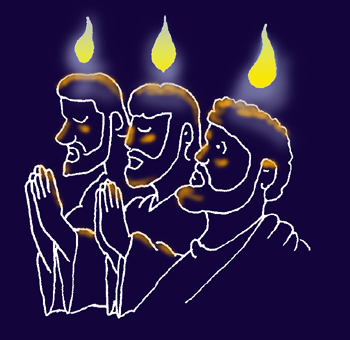
Many Christians today don’t realize how active God’s Holy Spirit was in the OT era. Some are surprised at the thought that people could be “born again” before the day of Pentecost. The confusion arises from the idea that the giving of the Spirit on Pentecost was the inauguration of all the Spirit’s ministries. In fact, the outpouring of the Spirit on Pentecost was only for the explicit purposes declared by Joel. Consider these observations about the OT prophecies of the Spirit’s outpouring:
(1) The OT prophecies of future outpouring or manifestation of the Holy Spirit fall under two great themes: The Coming of Messiah and The Restoration of Israel (see Plumb Lines pages 19 and 20).
(2) All the predicted ministries or manifestation of the Holy Spirit were already known, at least in part, in the OT era, having been witnessed in the lives of Moses and other Judges and prophets.
(3) Only Isaiah 59.20,21 (implicitly) and Joel 2.28-32 (explicitly) predict a prophetic or charismatic empowering of a large group of people. Both of these passages fall under the greater theme of Israel’s ultimate restoration.
(4) Joel’s prophecy stands out as unique among OT predictions of the Spirit on several counts:
A. While looking to the ultimate restoration of Israel, it applies to “all flesh,” grammatically the most general designation for people possible. Joel specifies the outpouring of the Spirit as upon both genders, all ages and all social stratas.
B. Joel’s prophecy specifies charismatic gifts and manifestations as the result of the outpouring, in contrast to the usual repentance from idolatry that is in view in the other prophecies of the Spirit and Israel’s restoration.
C. Rather than looking only to Israel’s restoration following the Apocalypse, Joel speaks of an outpouring of the Holy Spirit that precedes the Apocalypse! We noted that while Peter on the day of Pentecost quoted Joel 2 to the middle of verse 32, Peter cut off his quotation in mid verse (like Jesus in the synagogue of Nazareth) for Pentecost only brought fulfillment of the prophecy up to that point: Pentecost brought the pre-apocalyptic outpouring and a fresh opportunity for Israelites to call upon the name of the Lord for salvation, but Pentecost was not the Apocalypse and had no reference to Armageddon “survivors.”
(5) It becomes clear that the outpouring of the Holy Spirit on the day of Pentecost, was not a general outpouring for repentance and salvation; those ministries of the Spirit were already active and manifest. The outpouring of the Holy Spirit on Pentecost was specifically for charismatic empowering. Furthermore, that charismatic empowering was for accomplishing the great harvest that would occur in the course of obeying the Great Commission. It was no accident that the outpouring occurred on the day of the harvest festival of
Weeks. (6) Therefore, we really have no business celebrating Pentecost Sunday if we have no interest in the charismatic empowering of the Spirit. To think of the Pentecost outpouring as the beginning of the Spirit’s salvific ministries is false pneumatology. Israelites did repent and get saved by the power of the Spirit on Pentecost, but they could have experienced the new birth before that time: what was
not previously available to them (unless they were specially chosen prophets) was access to the charismatic gifts.
(7) Finally, understanding the unique and specific purpose of the Pentecost outpouring helps us realize that salvation (new birth) and charismatic empowering are distinct ministries of the Spirit and can be distinct events in the life of the believer. The chronological relationship between salvation and empowering by the Spirit is a topic we will take up at another time.




